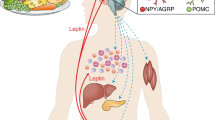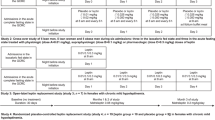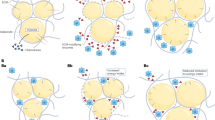Abstract
The assimilation, storage and use of energy from nutrients constitute a homeostatic system that is essential for life. In vertebrates, the ability to store sufficient quantities of energy-dense triglyceride in adipose tissue allows survival during the frequent periods of food deprivation encountered during evolution. However, the presence of excess adipose tissue can be maladaptive. A complex physiological system has evolved to regulate fuel stores and energy balance at an optimum level. Leptin, a hormone secreted by adipose tissue, and its receptor are integral components of this system. Leptin also signals nutritional status to several other physiological systems and modulates their function. Here we review the role of leptin in the control of body weight and its relevance to the pathogenesis of obesity.
This is a preview of subscription content, access via your institution
Access options
Subscribe to this journal
Receive 51 print issues and online access
$199.00 per year
only $3.90 per issue
Buy this article
- Purchase on Springer Link
- Instant access to full article PDF
Prices may be subject to local taxes which are calculated during checkout





Similar content being viewed by others
References
Harris, T. et al. Body mass index and mortality among nonsmoking older persons: the Framingham Heart Study. J. Am. Med. Assoc. 259, 1520–1524 (1988).
Stunkard, A. J., Harris, J. R., Pedersen, N. L. & McClearn, G. E. The body-mass index of twins who have been reared apart. N. Engl. J. Med. 322, 1483–1487 (1990).
Coleman, D. L. Obese and Diabetes: two mutant genes causing diabetes-obesity syndromes in mice. Diabetologia 14, 141–148 (1978).
Wadden, T. A. Treatment of obesity by moderate and severe caloric restriction. Results of clinical research trials. Ann. Intern. Med. 119, 688–693 (1993).
Hetherington, A. W. & Ranson, S. W. The spontaneous activity and food intake of rats with hypothalamic lesions. Am. J. Physiol. 136, 609–617 (1942).
Kennedy, G. C. The role of depot fat in the hypothalamic control of food intake in the rat. Proc. R. Soc. Lond. B 140, 578–592 (1953).
Friedman, J. M. & Leibel, R. L. Tackling a weighty problem. Cell 69, 217–220 (1992).
Zhang, Y. et al. Positional cloning of the mouse obese gene and its human homologue. Nature 372, 425–432 (1994).
Bado, A. et al. The stomach is a source of leptin. Nature 394, 790–793 (1998).
Masuzaki, H. et al. Nonadipose tissue production of leptin: leptin as a novel placenta-derived hormone in humans. Nature Med. 3, 1029–1033 (1997).
Moon, B. C. & Friedman, J. M. The molecular basis of the obese mutation in ob2J mice. Genomics 42, 152–156 (1997).
Maffei, M. et al. Increased expression in adipocytes of ob RNA in mice with lesions of the hypothalamus and with mutations at the db locus. Proc. Natl Acad. Sci. USA 92, 6957–6960 (1995).
Halaas, J. L. et al. Weight-reducing effects of the plasma protein encoded by the obese gene. Science 269, 543–546 (1995).
Cohen, S. L. et al. Characterization of endogenous human leptin. Nature 382, 589 (1996).
Maffei, M. et al. Leptin levels in human and rodent: measurement of plasma leptin and ob RNA in obese and weight-reduced subjects. Nature Med. 1, 1155–1161 (1995).
Halaas, J. L. et al. Physiological response to long-term peripheral and central leptin infusion in lean and obese mice. Proc. Natl Acad. Sci. USA 94, 8878–8883 (1997).
Pelleymounter, M. A. et al. Effects of the obese gene product on body weight regulation in ob/ob mice. Science 269, 540–543 (1995).
Campfield, L. A. et al. Recombinant mouse OB protein: evidence for a peripheral signal linking adiposity and central neural networks. Science 269, 546–549 (1995).
Stephens, T. W. et al. The role of neuropeptide Y in the antiobesity action of the obese gene product. Nature 377, 530–534 (1995).
Schneider, B. S., Friedman, J. M. & Hirsch, J. in Brain Peptides (eds Krieger, D., Martin, J. & Brownstien, M.) 251–280 (Wiley, USA, (1983)).
Spiegelman, B. M. & Flier, J. S. Adipogenesis and obesity: rounding out the big picture. Cell 87, 377–389 (1996).
Considine, R. V. et al. Serum immunoreactive-leptin concentrations in normal-weight and obese humans. N. Engl. J. Med. 334, 324–325 (1996).
Chehab, F. F., Lim, M. E. & Lu, R. Correction of the sterility defect in homozygous obese female mice by treatment with the human recombinant leptin. Nature Genet. 12, 318–320 (1996).
Lord, G. M. et al. Leptin modulates the T-cell immune response and reverses starvation induced immunosuppression. Nature 394, 897–891 (1998).
Ahima, R. S. et al. Role of leptin in the neuroendocrine response to fasting. Nature 382, 250–252 (1996).
Chehab, F. F., Mounzih, K., Lu, R. & Lim, M. E. Early onset of reproductive function in normal female mice treated with leptin. Science 275, 88–90 (1997).
Ahima, R. S. et al. Leptin accelerates the onset of puberty in normal female mice. J. Clin. Invest. 99, 391–395 (1997).
Mantzoros, C. S., Flier, J. S. & Rogol, A. D. Alongitudinal assessment of hormonal and physical alterations during normal puberty in boys. Rising leptin levels may signal the onset of puberty. J.Clin. Endocrinol. Metab. 82, 1066–1070 (1997).
Gavriloua, O., Barr, V., Marcus-Samuels, B. & Reitman, M. Hyperleptinemia of pregnancy associated with the appearance of a circulating form of the leptin receptor. J. Biol. Chem. 272, 30546–30551 (1997).
Tartaglia, L. A. et al. Identification and expression cloning of a leptin receptor, OB-R. Cell 83, 1263–1271 (1995).
Lee, G. H. et al. Abnormal splicing of the leptin receptor in diabetic mice. Nature 379, 632–635 (1996).
Li, C. et al. Absence of soluble leptin receptor in plasma from dbPas/dbPas and other db/db mice. J. Biol. Chem. 273, 10078–10082 (1998).
Chen, H. et al. Evidence that the diabetes gene encodes the leptin receptor: identification of a mutation in the leptin receptor gene in db/db mice. Cell 84, 491–495 (1996).
Bjorbaek, C., Uotani, S., da Silva, B. & Flier, J. S. Divergent signaling capacities of the long and short isoforms of the leptin receptor. J. Biol. Chem. 272, 32686–32695 (1997).
Ghilardi, N. et al. Defective STAT signaling by the leptin receptor in diabetic mice. Proc. Natl Acad. Sci. USA 93, 6231–6235 (1996).
Sierra-Honigmann, M. R. et al. Biologic action of leptin as an angiogenic factor. Science 281, 1683–1685 (1998).
Mercer, J. G. et al. Localization of leptin receptor mRNA and the long form splice variant (Ob-Rb) in mouse hypothalamus and adjacent brain regions by in situ hybridization. FEBS Lett. 387, 113–116 (1996).
Fei, H. et al. Anatomic localization of alternatively spliced leptin receptors (Ob-R) in mouse brain and other tissues. Proc. Natl Acad. Sci. USA 94, 7001–7005 (1997).
Vaisse, C. et al. Leptin activation of Stat3 in the hypothalamus of wild-type and ob/ob mice but not db/db mice. Nature Genet. 14, 95–97 (1996).
Woods, A. J. & Stock, M. J. Leptin activation in hypothalamus. Nature 381, 745 (1996).
Glaum, S. R. et al. Leptin, the obese gene product, rapidly modulates synaptic transmission in the hypothalamus. Mol. Pharmacol. 50, 230–235 (1996).
Spanswick, D. et al. Leptin inhibits hypothalamic neurons by activation of ATP-sensitive potassium channels. Nature 390, 521–525 (1997).
Satoh, N. et al. Pathophysiological significance of the obese gene product, leptin, in ventromedial hypothalamus (VMH)-lesioned rats: evidence for loss of its satiety effect in VMH-lesioned rats. Endocrinology 138, 947–954 (1997).
Kamohara, S., Burcelin, R., Halaas, J. L., Friedman, J. R. & Charron, M. J. Acute stimulation of glucose metabolism in mice by leptin treatment. Nature 389, 374–377 (1997).
Banks, W. A. et al. Leptin enters the brain by a saturable system independent of insulin. Peptides 17, 305–311 (1996).
Hakansson, M.-L. et al. Leptin receptor immunoreactivity in chemically defined target neurons of the hypothalamus. J. Neurosci. 18, 559–572 (1998).
Wang, M. Y. et al. Ob-Rb gene transfer to leptin-resistant islets reverses diabetogenic phenotype. Proc. Natl Acad. Sci. USA 95, 714–718 (1998).
White, D. W. et al. Leptin receptor (OB-R) signaling. Cytoplasmic domain mutational analysis and evidence for receptor homo-oligomerization. J. Biol. Chem. 272, 4065–4071 (1997).
DeVos, R. et al. Ligand-independent dimerization of the extracellular domain of the leptin receptor and determination of the stoichiometry of leptin binding. J. Biol. Chem. 272, 18304–18310 (1997).
Carpenter, L. R. et al. Enhancing leptin response by preventing SH2-containing phosphatase 2 interaction with ob receptor. Proc. Natl Acad. Sci. USA 95, 6061–6066 (1998).
Bjorbaek, C. et al. Identification of SOC-3 as a potential mediator of central leptin resistance. Mol. Cell 1, 619–625 (1998).
Friedman, J. M. The alphabet of weight control. Nature 385, 119–120 (1997).
Erickson, J. C., Hollopeter, G. & Palmiter, R. D. Attenuation of the obesity syndrome of ob/ob mice by the loss of neuropeptide Y. Science 274, 1704–1707 (1996).
Fan, W. et al. Role of melanocortinergic neurons in feeding and the agouti obesity syndrome. Nature 385, 165–168 (1997).
Huszar, D. et al. Targeted disruption of the melanocortin-4 receptor results in obesity in mice. Cell 88, 131–141 (1997).
Satoh, N. et al. Satiety effect and sympathetic activation of leptin are mediated by hypothalamic melanocortin system. Neurosci. Lett. 249, 107–110 (1998).
Ollmann, M. M. et al. Antagonism of central melanocortin receptors in vitro and in vivo by agouti-related protein. Science 278, 135–138 (1997).
Shutter, J. R. et al. Hypothalamic expression of ART, a novel gene related to agouti, is up-regulated in obese and diabetic mutant mice. Genes Dev. 11, 593–602 (1997).
Matson, C. A., Wiater, M. F., Kuijper, J. L. & Weigie, D. S. Synergy between leptin and cholecystokinin (CCK) to control daily caloric uptake. Peptides 18, 1275–1278 (1997).
Kristensen, P. et al. Hypothalamic CART is a new anorectic peptide regulated by leptin. Nature 393, 72–76 (1998).
Ohi-Hamazaki, H. et al. Mice lacking bombesin receptor subtype-3 develop metabolic defects and obesity. Nature 390, 165–169 (1997).
Woods, S. C., Chavez, M. & Park, C. R. The evaluation of insulin as a metabolic signal influencing behavior via the brain. Neurosci. Biobehav. Rev. 20, 139–144 (1996).
Qu, D. et al. Arole for melanin-concentrating hormone in the central regulation of feeding behavior. Nature 380, 243–247 (1996).
Sakurai, T. et al. Orexins and orexin receptors: A family of hypothalamic neuropeptides and G protein-coupled receptors that regulate feeding behavior. Cell 92, 573–585 (1998).
Schwartz, M. W. et al. Identification of targets of leptin action in rat hypothalamus. J. Clin. Invest. 98, 1101–1106 (1996).
Elmquist, J. K. et al. Leptin activates neurons in ventrobasal hypothalamus and brainstem. Endocrinology 138, 839–842 (1997).
Rohner-Jeanrenaud, F., Walker, C.-L., Greco-Perotto, R. & Jeanrenaud, B. Central corticotropin-releasing factor administration prevents the excessive body weight gain of genetically obese (fa/fa) rats. Endocrinology 124, 733–739 (1989).
Gardner, J. D., Rothwell, N. J. & Luheshi, G. N. Leptin affects food intake via CRF-receptor-mediated pathways. Nature Neurosci. 1, 103 (1998).
Freedman, M. R., Horwitz, B. A. & Stern, J. S. Effect of adrenalectomy and glucocorticoid replacement on development of obesity. Am. Physiol. Soc. 595–R607 (1986).
Gerald, C. et al. Areceptor subtype involved in neuropeptide-Y induced food intake. Nature 382, 168–171 (1996).
Tecott, L. H. et al. Eating disorder and epilepsy in mice lacking 5-HT2c serotonin receptors. Nature 374, 542–546 (1995).
Ioffe, E., Moon, B., Connolly, E. & Friedman, J. M. Abnormal regulation of the leptin gene in the pathogenesis of obesity. Proc. Natl Acad. Sci. USA 95, 11852–11857 (1998).
Verploegen, S. et al. Ahuman leptin mutant induces weight gain in normal mice. FEBS Lett. 405, 237–240 (1997).
Chen, G. et al. Disappearance of body fat in normal rats induced by adenovirus-mediated leptin gene therapy. Proc. Natl Acad. Sci. USA 93, 14795–14799 (1996).
Sivitz, W. I. et al. Effects of leptin on insulin sensitivity in normal rats. Endocrinology 138, 3395–3401 (1997).
Miles, P. D. G., Yamatani, K., Lickley, H. L. A. & Vranic, M. Mechanism of glucoregulatory responses to stress and their deficiency in diabetes. Proc. Natl Acad. Sci. USA 88, 1296–1300 (1991).
Haynes, W. G. et al. Receptor-mediated regional sympathetic nerve activation by leptin. J. Clin. Invest. 100, 270–278 (1997).
Collins, S. et al. Role of leptin in fat regulation. Nature 380, 677 (1996).
Zhou, Y.-T. et al. Induction by leptin of uncoupling protein-2 and enzymes of fatty acid oxidation. Proc. Natl Acad. Sci. USA 94, 6386–6390 (1997).
Frederich, R. C. et al. Leptin levels reflect body lipid content in mice: evidence for diet-induced resistance to leptin action. Nature Med. 1, 1311–1314 (1995).
Van Heek, M. et al. Diet-induced obese mice develop peripheral, but not central, resistance to leptin. J. Clin. Invest. 99, 385–390 (1997).
Naggert, J. K. et al. Hyperproinsulinaemia in obese fat/fat mice associated with a carboxypeptidase E mutation which reduces enzyme activity. Nature Genet. 10, 135–142 (1995).
Rovere, C., Viale, A., Nahon, J. L. & Kitabgi, P. Impaired processing of brain proneurotensin and promelanin-concentrating hormone in obese fat/fat mice. Endocrinology 137, 2954–2958 (1996).
Jackson, R. S. et al. Obesity and impaired prohormone processing associated with mutations in the human prohormone convertase 1 gene. Nature Genet. 16, 303–306 (1997).
Kleyn, P. W. et al. Identification and characterization of the mouse obesity gene tubby: a member of a novel gene family. Cell 85, 281–290 (1996).
Noben-Trauth, K., Naggert, J., North, M. & Nishina, P. Acandidate for the mouse mutation tubby. Nature 380, 534–538 (1996).
West, D. B., Boozer, C. N., Moody, D. L. & Atkinson, R. L. Dietary obesity in nine inbred mouse strains. Am. J. Physiol. 262, R1025–R1032 (1992).
Schwartz, M. W. et al. Cerebrospinal fluid leptin levels: relationship to plasma levels and to adiposity in humans. Nature Med. 2, 589–593 (1996).
Caro, J. F. et al. Decreased cerebrospinal-fluid/serum leptin ratio in obesity: a possible mechanism for leptin resistance. Lancet 348, 159–161 (1996).
Mandrup, S. et al. Obese gene expression at in vivo levels by fat pads derived from Sc implanted 3t3-F442a preadipocytes. Proc. Natl Acad. Sci. USA 94, 4300–4305 (1997).
Wang, J. et al. Anutrient-sensing pathway regulates leptin gene expression in muscle and fat. Nature 393, 384–388 (1998).
Saladin, R. et al. Transient increase in obese gene expression after food intake or insulin administration. Nature 377, 527–529 (1995).
Kiess, W. et al. High leptin concentrations in serum of very obese children are further stimulated by dexamethasone. Horm. Metab. Res. 28, 708–710 (1996).
Miller, S. G. et al. The adipocyte specific transcription factor C/EBPalpha modulates human ob gene expression. Proc. Natl Acad. Sci. USA 93, 5507–5511 (1996).
Devos, P. et al. Thiazolidinediones repress ob gene expression in rodents via activation of peroxisome proliferator-activated receptor gamma. J. Clin. Invest. 98, 1004–1009 (1996).
Ravussin, E. et al. Relatively low plasma leptin concentrations precede weight gain in Pima Indians. Nature Med. 3, 238–240 (1997).
Casanueva, F. F. et al. Serum immunoreactive leptin concentrations in patients with anorexia nervosa before and after partial weight recovery. Biochem. Mol. Med. 60, 116–120 (1997).
Mantzoros, C. et al. Cerebrospinal fluid leptin in anorexia nervosa: correlation with nutritional status and potential role in resistance to weight gain. J. Clin. Endocrinol. Metab. 82, 1845–1851 (1997).
Maffei, M. et al. Absence of mutations in the human ob gene in obese/diabetic subjects. Diabetes 45, 679–682 (1996).
Montague, C. T. et al. Congenital leptin deficiency is associated with severe early-onset obesity in humans. Nature 387, 903–908 (1997).
Strobel, A., Camoin, T. I. L., Ozata, M. & Strosberg, A. D. Aleptin missense mutation associated with hypogonadism and morbid obesity. Nature Genet. 18, 213–215 (1998).
Clement, K. et al. Amutation in the human leptin receptor gene causes obesity and pituitary dysfunction. Nature 392, 398–401 (1998).
Clement, K. et al. Indication for linkage of the human OB gene region with extreme obesity. Diabetes 45, 687–690 (1996).
Reed, D. R. et al. Extreme obesity may be linked to markers flanking the human OB gene. Diabetes 45, 691–694 (1996).
Comuzzie, A. G. et al. Amajor quantitative trait locus determining serum leptin levels and fat mass is located on human chromosome 2. Nature Genet. 5, 273–276 (1997).
Krude, H. et al. Severe early-onset obesity, adrenal insufficiency and red hair pigmentation caused by POMC mutations in humans. Nature Genet. 19, 155 (1998).
Murphy, J. E. et al. Long-term correction of obesity and diabetes in genetically obese mice by a single intramuscular injection of recombinant adeno-associated virus encoding mouse leptin. Proc. Natl Acad. Sci. USA 94, 13921–13926 (1997).
Blackburn, G. Effect of degree of weight loss on health benefits. Obes. Res. 3 (suppl. 2), 211–216 (1995).
Manson, J. E. et al. Body weight and mortality among women. New Engl. J. Med. 333, 677–685 (1995).
Acknowledgements
We thank S. Korres for assistance in preparing this manuscript and J. Froude for editing it, and D. Luck, J. Breslow, B. Schneider and M. Stoffel for critically reading it and for thoughtful comments. This work was supported by a grant from NIH/NIDDK (J.M.F.) and in part by an NIH MSTP grant (to J.L.H.).
Author information
Authors and Affiliations
Corresponding author
Rights and permissions
About this article
Cite this article
Friedman, J., Halaas, J. Leptin and the regulation of body weight in mammals. Nature 395, 763–770 (1998). https://doi.org/10.1038/27376
Issue Date:
DOI: https://doi.org/10.1038/27376
This article is cited by
-
Adipo-oncology: adipocyte-derived factors govern engraftment, survival, and progression of metastatic cancers
Cell Communication and Signaling (2024)
-
A negative feedback loop between TET2 and leptin in adipocyte regulates body weight
Nature Communications (2024)
-
Serum levels of adiponectin differentiate generalized lipodystrophies from anorexia nervosa
Journal of Endocrinological Investigation (2024)
-
Breast feeding, obesity, and asthma association: clinical and molecular views
Clinical and Molecular Allergy (2023)
-
Early-life residential green spaces and traffic exposure in association with young adult body composition: a longitudinal birth cohort study of twins
Environmental Health (2023)
Comments
By submitting a comment you agree to abide by our Terms and Community Guidelines. If you find something abusive or that does not comply with our terms or guidelines please flag it as inappropriate.



